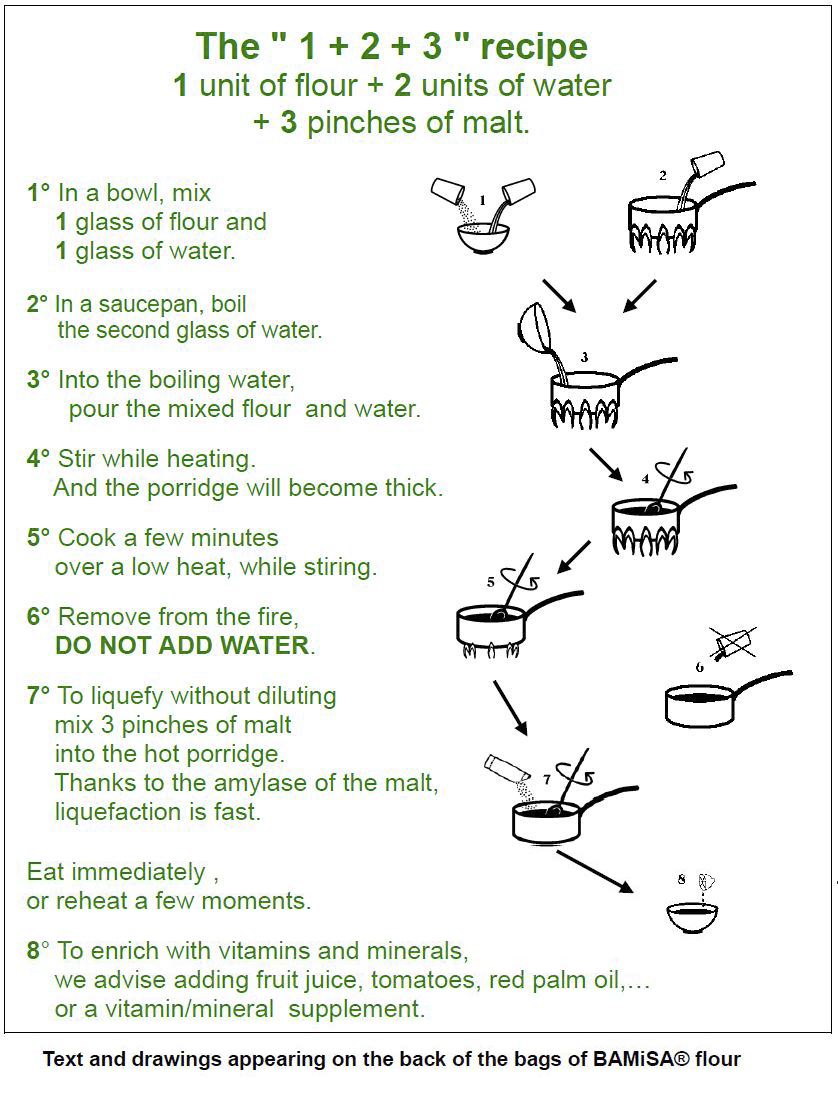Characteristics of the BAMISA PORRIDGE
Product sheet and receipe
05b2
February 15, 2022 Version
The BAMiSA porridge is a "liquefied concentrated porridge" (LCP), i.e. a porridge of high protein-energy value and low viscosity.
The porridge is made with BAMiSA flour. The flour ingredients are : cereal (pearl millet or maize), two fatty legumes (soy and peanuts), sugar and iodized salt.
Its preparation is specific : “a lot of flour for a little water”. Indeed, after a quick boil, it becomes very thick. While it is still warm, a local amylase is then added to liquefy it.
The ‘’1+2+3’’ formula sums up its preparation mode : 1 stands for one volume of water, 2 stands for two volumes of flour and 3 stands for three pinches of malt. |
The large quantity of flour compared to the small amount of water enables the BAMiSA LCP to reach a concentration of 30% dry matter, i.e. three to four times more than traditional porridges.
The starch degradation due to the introduction of amylases enables to get rid of the dietary bulk effect of traditional porridges. Liquefaction enables quick and complete consumption of LCPs as well as their easy digestion. This liquefaction process avoids the disastrous dilution of thick porridges with water.
The mother can replace the three pinches of malt by a small quantity of her milk or she can wet the spoon with her saliva before mixing the porridge. Milk and saliva are rich in amylases.
The Nutritional Value of BAMiSA porridge
The basics for a BAMiSA porridge are the ‘’1 + 2 + 3’’ recipe which has a 200 ml volume (about a bowl-full). Its caloric value is about 250 Kcal.
Two BAMiSA porridges provide a ration of 500 Kcal, equivalent to one sachet of RUTF.
USERS of BAMiSA porridge
Young children
- Children over the age of six months, as a supplement to breast-feeding, one BAMiSA porridge contributes to prevent malnutrition.
- As early as four months old, in case of irreversible deficit of maternal milk and also for orphaned children, a BAMiSA porridge a day can be given in complementation of a milk diet.
- BAMiSA flour is to be used until the child is able to have its nutritional needs satisfied by the traditional family food.
Malnourished children
- Children at risk of malnutrition or suffering from moderate malnutrition, or undergoing phase 1 of a severe acute malnutrition treatment need two BAMiSA porridges to be added to their usual food. A mineral-vitamin complementation (CMV) must be associated.
Older children and adults
- Plan 2 to 3 porridges for sick or malnourished adults (chronic illnesses, HIV positivity, surgery).
- One porridge a day may be beneficial to school-aged children, pregnant or breast-feeding women and aged people.
If the consumer prefers a thicker porridge, don't add the malt.
BAMiSA flour can be “enriched” with fruit juice, moringa oleifera leaves, red palm oil, or “fortified” by adding micronutrientsThe BAMiSA Porridge Recipe
The BAMiSA porridge is a Liquefied Concentrated Porridge. It respects three principles :
- 1° The Control of the water/flour proportions :
Mix « 1 volume of flour for 2 volumes of water »,
i.e. for one bowl of porridge : « 60 g of flour and 200 ml of water ». - 2° A brief cooking
Boil for 1 or 2 minutes until the porridge becomes thick. The cereal and the fatty legumes have been precooked by their preliminary roasting. - 3° The amylasic liquefaction of the porridge
The " 3 pinches " of malt, mixed gradually into the hot porridge, leads to its liquefaction. The maternal milk or traces of maternal saliva on the spoon, both being rich in amylases, can also cause a quick liquefaction.

